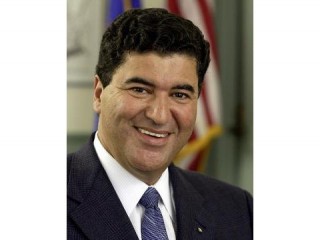
Elias A. Zerhouni biography
Date of birth : 1951-04-12
Date of death : -
Birthplace : Algeria
Nationality : Algerian-American
Category : Science and Technology
Last modified : 2011-09-27
Credited as : radiologist, medical researcher, NIH
0 votes so far
Born in 1951, Zerhouni is a native of the Algerian city of Nedroma, and was a competitive swimmer during his teens. In addition to Arabic, he also speaks French fluently-a legacy of the North African land's colonial history-and learned English as well. When he completed his medical studies at the University of Algiers, he applied for and won residency at Johns Hopkins University, considered one of the leading medical and teaching facilities in the United States.
Zerhouni arrived in the United States in 1975, bringing his wife, Nadia, and just $300 with him. Three years later, he finished his residency in diagnostic radiology and began teaching at the university as well. He was at the forefront of important new advances in diagnostic radiology, gaining expertise in CAT scans (computer axial tomography) and magnetic resonance imaging (MRI), each of which speeded the diagnostic process immensely without the need for exploratory surgery. In addition to teaching, Zerhouni also conducted his own research, developing techniques and devices that helped radiologists more accurately assess pulmonary tumors and heart functions.
In 1992, Zerhouni was made a full professor at Johns Hopkins, and eventually became a vice dean and chair of its radiology department. Over the next decade, he emerged as a respected administrator at the school of medicine, creating a strategic plan for research and winning funds for new and advanced facilities. His efforts attracted the attention of the White House, which nominated him to become the new director of the National Institutes of Health (NIH) in March of 2002. He was approved by Senate vote on May 2, 2002, and sworn in 18 days later.
The NIH director's office had been vacant for two years. Some Washington political observers believed that the Bush Administration's delay in filling the post was linked to finding a suitable candidate who shared the White House line on embryonic stem-cell research. Scientists were eager to explore the possibilities that such cells, which come from human embryos that went unused in in-vitro fertilization (IVF) techniques, might yield. These are cells that develop in embryos within the first two weeks of the life stage, and they provide the building blocks for some of the 200 other cells in the human body. Stem-cell therapies, it is believed, might bring important advances in the treatment of spinal-cord injuries, some forms of blindness, diabetes, and Alzheimer's and Parkinson's diseases.
Many religious groups, from American conservative Christians to the seat of the Roman Catholic church at the Vatican, oppose certain aspects of embryonic stem-cell research. Linking it to human cloning, they object on the grounds that scientists are attempting to tamper with the sanctity of human life. Some also believe that unregulated research might inspire women to undergo IVF procedures, and then sell the results. In August of 2001, President Bush signed an order that served as a compromise, in effect, but one that pleased neither side: federal funding on any future stem-cell research would be limited to projects that used the 78 existing colonies of stem cells.
The president's appointment of Zerhouni to the NIH post several months later was also viewed as a compromise. "Dr. Zerhouni shares my view that human life is precious and should not be exploited or destroyed for the benefits of others," Bush said, according to an article by Virginian Pilot journalist Liz Szabo. Zerhouni has consistently defended White House policy on the matter, and noted that confining federally funded research to the existing lines was adequate for the time being. If scientific progress was slowed by lack of laboratory resources, he said in late 2003, "I'll be the first to go the president and say we have reached a point where we need a debate here," the New York Times quoted him as saying. Such assertions prompted some to term the doctor an ideal person for the politically sensitive NIH post. Writing in the San Francisco Chronicle, Keay Davidson noted that Zerhouni "has demonstrated a mastery of Washingtonspeak-the ability to discuss controversial topics without alienating anyone."
Zerhouni supervises an agency with 27 separate institutes and centers, such as the National Institute on Aging and the National Cancer Institute, and which funds more than 2,000 biomedical projects around the world. It employs 18,000 people and has a Congressionally mandated budget of $27 billion. In September of 2003, Zerhouni introduced a "roadmap" for future medical research, a plan designed to bring together scientists working in molecular biology and clinical medicine. In an interview with the New York Times ' Denise Grady two months earlier, Zerhouni had termed "life sciences the core challenge of the 21st century. For thousands of years medicine has relied on what? On the fact that you have a core of people to whom you come when a disease has declared itself." In the future, he asserted-thanks to advances in molecular biology-"we're going to have to understand what I call the subclinical phase of diseases, where the disease is evolving in you but you feel nothing."
Zerhouni's wife is also a doctor and they are the parents of three children. He became a naturalized United States citizen in the early 1980s. In the New York Times interview with Grady, he reflected back on his career path that led him to the prestigious NIH post.
















